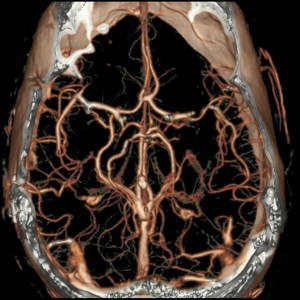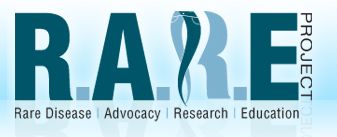Moyamoya: Puff of Smoke
Moyamoya disease is a rare, progressive cerebrovascular disorder caused by blocked arteries at the base of the brain in an area called the basal ganglia. The name “moyamoya” means “puff of smoke” in Japanese and describes the look of the tangle of tiny vessels formed to compensate for the blockage. The syndrome is characterized by intracranial vascular stenoses of the circle of Willis (see image below), resulting in successive ischemic events. The circle of Willis (also called the cerebral arterial circle, arterial circle of Willis or Willis Polygon) is a circle of arteries that supply blood to the brain. Hemorrhagic events can also occur. The condition leads to irreversible blockage of the carotid arteries to the brain as they enter into the skull. It is a disease that tends to affect both children and adults at any age from 6 months to 67 years, with the highest peak in the first decade and smaller peaks in the third and fourth decades. In children it tends to cause strokes or seizures. In adults it tends to cause strokes or bleeding. The clinical features are cerebral ischaemia (strokes), recurrent transient ischemic attacks (TIAs), sensorimotor paralysis (numbness in the extremities), convulsions and/or migraine-like headaches.

The incidence of moyamoya disease is highest in Japan. However, a recent study indicated that the prevalence in California and Washington was 0.086 case per 100,000 population. In this study, the breakdown based on ethnicity as ratio to whites was 4.6 for Asian Americans, 2.2 for African Americans, and 0.5 for Hispanics. The prevalence and incidence of moyamoya disease in Japan has been reported to be 3.16 cases and 0.35 case per 100,000 people, respectively.
Dr. Frederic Meyer, a Mayo Clinic neurosurgeon discusses Moyamoya disease and what to look for when seeking care for moyamoya disease. For more information about the Department of Neurosurgery at Mayo Clinic, click here.
Magnetic resonance imaging (MRI and MRA) and occasionally computed tomography (CT) scans give the initial indications of moyamoya disease. The standard – both for diagnosing the disease and for planning surgery – is a cerebral angiogram. A dye that shows up on x-rays is fed into the carotid artery and a series of x-ray images are taken. Both the narrowed artery and the proliferation of new blood vessels (the “puff of smoke,” for which the disease is named) show up in sharp relief. All angiograms carry some risks, which are slightly greater in children with moyamoya, so a highly-skilled angiographic team is essential.
There are several types of revascularization surgery that can restore blood flow to the brain by opening narrowed blood vessels or by bypassing blocked arteries. Children usually respond better to revascularization surgery than adults, but the majority of individuals have no further strokes or related problems after surgery. Without surgery, the majority of individuals with Moyamoya disease will experience mental decline and multiple strokes because of the progressive narrowing of arteries. Without treatment, Moyamoya disease can be fatal as the result of intracerebral hemorrhage. Mortality rates of moyamoya disease are approximately 10% in adults and 4.3% in children. Death is usually from hemorrhage. About 50-60% of affected individuals experience a gradual deterioration of cognitive function, presumably from recurrent strokes.
In this video, Gary Steinberg, MD, PhD, neurosurgeon at Packard Childrens Hospital and professor and chair of neurosurgery at the Stanford University School of Medicine, performs revascularization surgery on a Moyamoya patient, September 16, 2008. Steinberg has the largest and most successful program in the world for treating the rare and mysterious disease.
Links:
MoyaMoya.com
National Stroke Association
Children’s Hemiplegia and Stroke Assocn. (CHASA)
MoyaMoyaInfo
Lost on the Floor: tales of a (new) nurse
Neurosurgical FOCUS Readers’ Forum: April 2009 Podcast
surgical treatment of moyamoya syndrome in patients with sickle cell anemia
Life’s a Journey, Join Me for Mine
Stroke Notes: North American Moyamoya is Different
@sm579417 Moya Fact: Moyamoya disease is a rare disorder described by progressive intracranial vascular stenoses of the Willis Polygon, causing stroke
In the News:
>
A stroke patient’s long road from healed to healer: Janel Nadeau
by André Picard in The Globe and Mail










I am a 40 year old female, in good mental and physical state of being. Recently I had two strokes at once and was hospitalized. I have also have von willebrand and lupus. While in the hospital undergoing several tests, on my medical report it implies possible unilateral moyamoya disease. What can I do to make sure I am in the right hands in the medical field? and that something like this does not get over looked, are there questions or concerns I should be asking these doctors? Your help would be greatly appreciated. Also the MRA had shown I have had multiple strokes prior to this last episode.
Thank You,
Trish
Contact Dr. Steinberg at Stanford Medical Center. You can send him your scans and he will consult with you regarding treatment options. Also, join the online community of Moyamoya survivors, family & friends at http://www.moyamoya.com